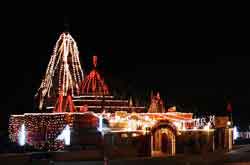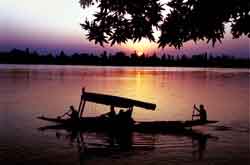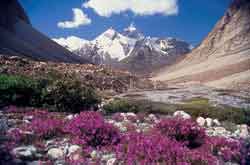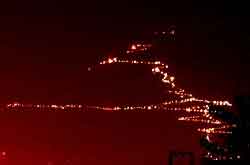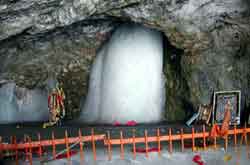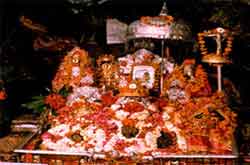Jammu is a transition between plains of Punjab in south & the Himalayan range in north
"Nestled against the backdrop of the snow-capped Pir Panjal Mountains, the region of Jammu constitutes the southernmost unit of the state of Jammu & Kashmir. It forms part of the transition between the Himalayan range in the north and the dusty plains of Punjab in the south.".
Between these two extremities lie a series of scrub-covered hills, forested mountain ranges and river valleys, encompassing several microclimatic regions that extend from Kishtawar in the north-east to Akhnoor in the south-west, and the historic town of Poonch in the north-west to the borders of Kangra (HP) in the south-east. The Shivalik hills cut across the area from the east to the west while the rivers Ravi, Tawi and Chenab cut their way through the region.
Physically, the region of Jammu is not homogenous. It is broadly divisible into three discernible zones determined by the terrain condition and the geo-climatic environment.
The southern-most of these is the ‘Outer Plains’ zone comprising the skirt of level lands in Jammu and Kathua districts which merge into the plains of Punjab. Toward its north and north-east rises the ‘Outer Hills’ zone attaining heights of 2000 to 4000 ft above mean sea level. Basohli, Reasi and better parts of Rajouri district fall in this zone. The landscape here shows open scrubs that gradually thicken from low scrub to taller trees of acacias, rhododendrons, cacti, etc. Above this zone, the terrain becomes acute in incline, the vegetal cover rich and the climatic conditions increasingly salubrious.
This is the region of the Middle Himalayas comprising several upland valleys of great natural beauty such as Kishtwar, Bhaderwah, Poonch and higher parts of Rajouri district. The average altitude of this zone ranges from 8000 to 10,000 ft. The mountains here are covered with thick forests of oak and chestnut, and higher up with deodar and pine. The majestic Chenab drains this beautiful landscape, carving spectacular gorges in its long and serpentine course.
Beyond and above the middle Himalayas lies the Pir Panjal Range which separates Jammu province from the Kashmir Valley. And in the extreme north-east rises the Great Himalayan Range itself, which forms a natural barrier between the Kishtwar region of Jammu and the Suru-Zanskar area of the Ladakh region. In its south-east to north-west sweeping arc, the Great Himalayan Wall soars to a maximum height of 7,135 m in the Nun-Kun massif, while dipping to 3,505 m at Zoji-la. Between these two extremities, this mighty range rises into dozens of perpetually snow-capped peaks and depresses into several passes connecting the two contrasting environments on its north and south.
The city of Jammu, the winter capital of the state, is the epicentre of all socio-economic activities in the Jammu region. It is also the base for visiting various centres of tourist and pilgrimage interest in which the region abounds.
City Climate
| Area |
20.36 sq.kms |
|
| Altitude |
305 m |
|
| Temperature |
Maximum |
Minimum |
| |
Summers:
43.0 C |
23.4 C |
| |
Winters:
26.2 C |
4.3 C |
| Rainfall |
107 cms (July to September) |
| Best Season |
September to April. |
| Clothing |
Summers: |
light cottons |
| |
Winters: |
woollens |
| Population |
6,98,674 (as per Census 2001) |
| Spoken Languages |
Dogri, Hindi, Punjabi, Urdu and English |
Culture - Jammu region is home to several ethnic communities which follow traditional life-styles with distinctive cultures of their own. Among these communities, the Dogras constitute the dominant group. They are mainly concentrated in the outer hill and outer plain zones covering Kathua, Udhampur and Jammu districts and the lower parts of Rajouri district. A martial community by tradition, their folklore centres on eulogies for war heroes, both legendary and historical. Even the region’s architectural heritage, comprising elaborate castles and hilltop fortifications that are visible everywhere, bespeak the community' s long-drawn preoccupation with battles and ruling of distant lands. Yet the region’s history is not completely bereft of traditions of art and culture. Thus, while the troops fought battles in distant areas, the royalty and the nobility nurtured art and culture. The Pahari miniature paintings that have justly become famous throughout India, are the finest examples of their artistic achievements.
The second largest ethnic group of the region is formed by the Gujjars, a semi-nomadic people living along the hill slopes of Doda and Rajouri districts while in Poonch they also dominate the main valleys. Some of them have settled down to agriculture, but the majority are primarily herdsmen. They cultivate maize along the slopes of the mountains, but only as a secondary occupation.

